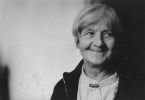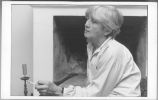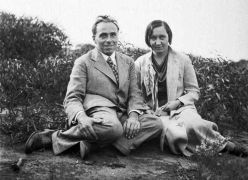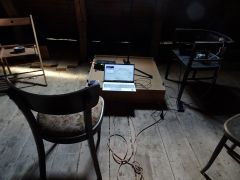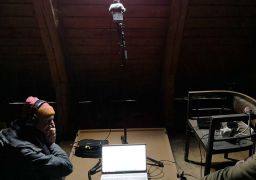An anthology of recordings of bird calls and the environment dedicated to Olga Karlíková and Jiří Baum.
“Birds had both a metonymical and metaphorical role in the ancient world. Through the action of flying they were perceived as linking the earth with the sky, and, as such, were deemed messengers of the gods. Also specific species such as larks were associated with the morning, nightingales with the evening and swallows with the arrival of spring. A literary formula often mentioned by Homer describes ‘winged words’ as those that fly from the mouth or off the page, birdlike. Olga Karlíková’s windy and winged graphic markings deliver a mesmerizing flow chart of different calligraphic ripples/pulses that place bird life directly into contact with the luminous qualities and presence of paper. These drawings made while listening to birds bring to mind the great open aviary depicted in the seventeenth century painting by Roelant Savery titled ‘Landscape with Birds’ and is housed in the Prague Castle. Surely this extraordinary painting would have been of special interest to Karlíková. Thinking of which (and evoking the kind of imaginary biography used by the great Symbolist writer Marcel Schwob) one could readily envisage Savery and Karlíková meeting and exchanging a fascinating set of anecdotes or impressions while purveying the Bohemian countryside together. For both artists considered ancient and contemporary worlds simultaneously; both in quite different ways highlight the poetical, mythological and quotidian significance of birds in our worldview. For Claude Levi-Strauss points to the archetypical role of birds to both resemble humans and also remain fundamentally different. He explains that birds: “… form a community which is independent of our own, but precisely because of this independence appears to us like another society, homologous to that in which we live: birds love freedom; they build themselves homes in which they live a family life and nurture their young; they often engage in social relations with other members of their species; and they communicate with them in acoustic means recalling articulated language. Consequently everything objective conspires to make us think of the bird as a metaphorical human society. (Savage Mind 204-05.)”
Marcus Bergner on the bird drawings of Olga Karlíková, Prague, April 2013
The so-called “Biosphere Open Microphones” is a form of sound technology which virtually connects various places, (for example natural reservations), with their distant listeners. The impulses which are picked up by microphones in real time travel through the network to an web-based streaming server, usually in the form of closed data packets intended for scientific or newscasting purposes, but sometimes as freely accessible information which serves not only scientists, but also artists or activists. The monitoring of acoustic spaces of select niches which have ecological meaning has for years been used as a tool for analyzing the natural environment, but it can also be considered a tool for experiencing and celebrating the richness of the sound environment of oftentimes hard-to-reach places.
One of the projects which makes use of such digital technology which records and mediates soundscapes is Reveil – a project initiated by the London-based Soundcamp collective. This event offers the listener a chance to perceive various natural acoustic environments and consists of a network of people who, at an agreed-upon moment, go and hold a microphone in their hand (or place it on a mic stand).
The International Dawn Chorus Day – the day on which Reveil takes place every year – was inaugurated in 1984 in the then-industrial landscape near Birmingham and set to take place every first weekend in May. It was founded mostly thanks to the British Ornithological Society, that being the profession with the closest connection to birdsong. Reveil is an artistic event and does not necessarily focus only on determining the species of the birds heard, but rather works to value the soundscape through its overall structure, harmony and richness. People thus leave the comfort of their own homes, sleep outside in tents or under the night sky and listen, and sometimes also record, these wondrous soundscapes.
A group of British sound artists and activists called Soundcamp began collaborating with numerous institutions, such as the Locus Sonus art collective bound to the university in Aix-en-Provence and who technically run the open microphone project, as well as a streaming server which provides the technological means to livestream from various locations around the globe. The Reveil radio program starts early morning Saturday in London, and runs for 24 hours, following the edge of light and darkness as it slowly moves towards the west, until it again reaches the Greenwich meridian on Sunday morning, as if the planet had taken possession of its otherwise troublesome technologies in order to put a word in.
Hundreds of people from Europe, the Americas, Asia, Australia and Africa joined the relay broadcast in 2020. The internet broadcast was coordinated by Grant Smith and Hannah Kemp-Welch for Soundcamp London, Maria Papadomanolaki in Crete, Darren Copeland from the NAISA organization in Canada and Leah Barclay from the Biosphere Soundscapes project from Australia’s Queensland coast, and the signal was also streamed by a number of community-run radio stations. Partner institutions of the Reveil broadcast include the Full of Noises collective in Cumbria, Locus Sonus, Radio CONA in Ljubljana, HMU of Crete and Cyberforest from Tokyo. It was a unique philanthropic, voluntary, civic initiative, which takes place in generous collaboration with the singing birds of the wider world.
Due to the 2020 pandemic, this year’s Reveil had a special flavor to it, as the internet became a space where even those who hadn’t been using it much suddenly started spending a considerable amount of time there. For the first time in decades, air traffic ceased almost everywhere and sounds which would have otherwise been drowned out by airplane engines became audible again. An unexpected and unusual silence, perhaps jolting for some, became the impulse to take the ear buds out, open the window and listen to how magical the world-in-itself in fact sounds.
Morning birdsong can sound bucolic to us, but birds sing for practical and prosaic reasons. It is mostly the males who sing, while females remain silent and listen attentively. The adult or adolescent male song says something like: “Here I am! Hey! Me, me, me! I am sitting here and my voice is heard far and wide! And I sing the best of all the guys around! All you other males better watch out! This is my spot and no one else has any reason to enter! (I am also glad that I survived the night, haven’t starved and wasn’t swallowed by some mean predator.)”
The mornings are still cold and the insects are tucked away somewhere. That is why there is no reason to go out in search of food. Birds prefer to use this part of the day for exercise through which they maintain their good physical condition. Although singing is hard work, and despite the fact that people often think so, they never sing just for the fun of it.
Sound ecologist Bernie Krause found out that birds (and other singing organisms) use their vocal cords (or they rub their legs together in what’s called stridulation) to craft something like personal acoustic niches – their own virtual sonic territories. The organisms adjust their vocalizations by frequency and time-shifting to compensate for vocal territory occupied by other vocal creatures, so this practice maintains inter-species solidarity, and they are usually not in competition (unless they are from the same family or species). If one usual pattern disappears from or is added to the acoustic soundscape, the biological coalition quickly adapts to this change and fills the “empty” sound niche. New sounds, like mechanical sound pollution in urban environments, force birds to sing louder in order to be heard.
Some bird species, like ostriches, birds of prey, ravens, owls, hummingbirds and penguins usually do not waste time on morning song. This might have to do with their means of subsistence, while for others – such as crows, ravens or parakeets, which are beings with vast mental capacities – it might be that they find the morning voice exertions to be rather foolish. But to what degree is it foolish or beneficial for a person to get up early in the morning in order to hear the dawn chorus? Does it make sense to listen to bird voices when we have so much beautiful, rhythmic and exhilarating human music and booming sounds all at the ready? The dawn chorus usually sounds nice to human ears, especially in the morning, when the landscape resonates with dynamic richness, diversity and complexity. But why do (at least some) people enjoy listening to bird females being wooed? Does such a feeling stem from our phylogenetic memories of cohabiting with birds in treetops somewhere in South Africa, Or did morning bird song for hundreds of thousands of years indicate that no danger was imminent? At a time of climate crisis, birds, much like insects and mushrooms, serve as great bio-indicators of the health of a particular landscape, or biotope. They indicate the quality and condition of the trees, plants, soil, water and air. If birds remain silent during the morning, that does not mean that it is less “nice” or “pleasant” outside. Through their vocalisations, the landscape indicates that something is right, or not right, that it might be suffocating because of poisons and garbage which we strew among the fields and meadows. Birds and insects might be silent because the land is drying up, the insects have moved elsewhere and the birds went with them. But the silence of birds and insects also signals the advent of an approaching era of hunger. If we do not hear at least twenty species singing outside our windows in the morning, this is a call to action, an SOS. A world without birdsong, without the chirping of grasshoppers and crickets, without the buzzing of bees, the baaing of sheep and goats and the lowing of cattle, could quickly turn into a nightmare for the human.
Selected Recordings from Reveil 2020
1. Waterfowl These birds were recorded in an ornithological nature reserve near Lázně Bohdaneč in Eastern Bohemia. The wooden shelter designed for bird observation was occupied by a homeless man that night, so I found a spot outside on the grass. There are many kinds of birds living in the reserve, including collared flycatcher, bluethroat, bearded reedling, and western yellow wagtail.
Recordist: Matěj Kratochvíl is a musicologist, journalist, and an amateur musician. He has started recording non-musical sounds as a side effect of his research in ethnomusicology. He also occasionally uses them in improvised music sessions with his friends, where he combines electronics mainly with woodwind instruments. Apart from that, he also plays folk music from Moravia.
2. Raining in Kravín
I hung up an old Tascam DR 70D recorder under the staircase outside and connectd an Uši microphone assembled by Jonáš Gruska. There is something inhuman about recording the rain and birds at dawn while reading a book upstairs, being elsewhere. I recognized 26 different birds; most are common here.
Recordist: Guy van Belle is a Belgian media artist and curator living in the Czech Republic. Kravín Rural Arts is situated in the Vysočina region of the Czech Republic, a hilly area of Železné hory, in the small village Hranice u Malče. KRA establishes long-term programs in the countryside with artists and other organizations who are interested in the ecological reconversion of the (media) arts.
kraland
3. Farm in Skryje I attached microphones to the rooftop of a barn facing a garden with a small pond. You can hear a rich local bird choir, also mixed with the distant sounds of forest birds and interrupted by the early voices of roosters. I was surprised at how rich the rural soundscape was so early in the morning and I’m still fascinated by listening to the sounds of that place at other times of day, too. A rare white-tailed eagle also nests on the rocks below the house in the valley, just above the Berounka river.
Recordist: Michal Kindernay is an intermedia artist, curator and performer. His audio-visual installations connect art, film, technology and science. He reflects ecological issues through various technological approaches in relation to the natural environment. His works include video performances, interactive installations, experimental documentary projects and sound compositions. He is one of the founders of the yo-yo non-profit culture organization and an initiator of the RurArtMap project. As an organizer and artist, he has been involved in many international projects. He works and lives in Prague.
4. At the Edge of the Forest in Rusava I broadcast from the village Rusava in northeastern Moravia, where I grew up and where I have listened to the soundscapes since my early childhood. There is a meadow with some old fruit trees, all surrounded by forest. On one side, the forest was cut down last year because of the bark beetle infestation and only a few trees remain. From this direction you can hear the sound of the drumming woodpecker. However, the whole recording starts with the occasional hooting of a little owl. Its voice is then gradually intertwined with the singing of a thrush and a blackbird. At the beginning, the dawn chorus ends when an awakened insect flies around the microphones.
Recordist: Tomáš Šenkyřík is a musicologist and field recordist, interested in acoustic ecology and discovering musical structures in nature. He lives in Židlochovice, south Moravia. He likes listening to nature without noise pollution, especially its delicate and quiet sounds. He has worked in the Museum of Romani culture as an ethnomusicologist, and is a member of Skupina, an artist group interested in field recordings, soundscapes, oral-aural history, and acoustic ecology. He is a founder of soundscape.cz
5. Under a Canopy in Mnichovice A recording of dawn taken under the canopy of our unfinished house near Prague. ORTF mics were set in the same direction as the slope leading to a small valley below, on the Budíkov hill where there are bushes, overgrown gardens, managed gardens of a few permanently inhabited houses or holiday cottages, all on the village’s very edge. There are only the fields and the forest beyond. Along with bird song, the D1 motorway leading from Prague to Brno and the railway heading to south of Bohemia are both slightly audible, depending on wind direction.
Recordist: Ladislav Železný is a sound designer, music director and producer for the radio drama department of the Czech Radio Vltava. He concentrates on sound art, listening, soundscapes, sound gathering, sound footage and sound-specific, handmade musical instruments, technologies, experiments and manipulation of sound as a non-visual and non-verbal medium, sound and music composition for short films, theater and radio drama, audio maps, and internet radio broadcasting. He lives in Mnichovice.
radiocustica.cz
6. Inner courtyard, Praha Vinohrady The recording was made in a quiet courtyard with no parking places inside, so you can hear people’s presence from the open windows. Early morning, just as the city and its noise is slowly waking up. You can hear the bird sounds with a particular resonance, which tells of the inner courtyard’s depth. The space is a place for children's games, people’s conversations and quarrels and also fights between cats and birds, as well as an attack of magpies on the nest of peaceful blackbirds. Recordist: Michal Kindernay (see no. 3).
7. From my window in Prague
This is a dawn recording of birds and rain from my window in Prague 6, overlooking a wooded park called Smiřického. The park is home to many doves, jays, magpies and numerous kinds of little birds I don’t know the names of. The recording begins just after daybreak on March 21, 2020.
Recordist: Lloyd Dunn’s current work is embodied in the filecast project ( nula.cc ) which began in 2009. New filecasts appear at the project’s “online presence” at frequent, though irregular intervals, and may be freely downloaded and shared.
nula.cc
8. Rural landscape in Mooste
This spring I made a habit of leaving my audio recorder out overnight once or twice a week since March to capture the full evening and dawn chorus and whatever may occur in between during the depths of night. Because of the Corona virus ‘lockdown’ there has been less plane traffic above and local traffic on the ground which makes for less human-imposed noise on the soundscape. I wanted to take advantage of that, to document and hear what it sounds like when the human world fades away and animal life takes center stage. This recording is from about an hour before dawn in a small forest just a few hundred meters from my house. There is a rich mix of bird life and a few frogs but the highlight are the calls of a pair of common cranes nearby about halfway through.
Recordist: John Grzinich has worked since the early 1990s as a freelance mixed-media artist and cultural coordinator with various practices combining sound, image, site, and collaborative social structures. His primary interest is working with sound, combining such divergent methods as field recording, filmmaking, electro-acoustic composition, performance, acoustic perception and listening awareness.
maaheli.ee
9. Presbytery in Branišov
The microphone was placed in the window in the attic of a former Baroque presbytery in Branišov, a small village in the Czech Moravian highlands, about 100 km southeast of Prague. The church and the cemetery are approximately 50 m from the building, and behind the cemetery there is a small forest. At the beginning of the recording you can hear quietly creaking tree branches. Then the birds start their morning prayer and then the rain comes.
Recordist: Stanislav Abrahám is an audiovisual performer and sound artist. He has worked as a sound designer in collaborative projects in for theatre and dance productions. As an independent artist he has realized installations in galleries, radio art composition for Czech Radio as well as conceptual work for sound in public space. His main interests include telecommunications, recording media and the phenomenon of the "disembodied voice".
stanislavabraham.cz
10. A statement of an anonymous bird who seems to prefer staying nameless and free from anthropocentric taxonomic systems
Location Mountshannon, Eastern Clare, Ireland
Recordist: Slavek Kwi is a sound artist, composer and researcher interested in the phenomena of perception as the fundamental determinant of relations with reality. He has a longstanding fascination with sound environments, developing what he terms ‘electroacoustic sound-paintings’ that oscillate between sound only works and interdisciplinary works exploring social, spatial and temporal processes. These complex audio-based situations are created mainly from site-specific recordings, resulting in subjective reports for radio broadcast, ‘cinema for the ears’ for multi-channel playback, sound installations integrated into the environment and performances. From the early nineties, Slavek has operated under the name Artificial Memory Trace.
artificialmemorytrace.com
11. The Columbiadamm Cemetery
A fox barks near the beginning of this recording. Birds singing include a nightingale, blackbirds, chaffinch and various tit species. The recording was made on May 3 together with Udo Noll, who was streaming for the Reveil project set up by Soundcamp. It was great, and rather moving, to be there and feel part of this wonderful worldwide cooperation that seemed particularly significant this year. It had special resonance, not only during the time of Covid-19 lockdown but for its unifying world view, giving space to non-humans while still acknowledging what humans have to offer and bringing together scientists, artists and anyone interested to contribute on an equal basis. Such a positive vision. Columbiadamm Cemetery is one of oldest in Berlin and is of mixed faith. The recording spot was in the Islamic section.
Recordist: Petr Cusack is a field recordist, musician and researcher with a long interest in the sound environment. His projects include community arts, research into sound and our sense of place and documentary recordings in areas of special sonic interest. His project Sounds from Dangerous Places explores soundscapes at sites of major environmental damage – the Chernobyl exclusion zone; Caspian oil fields; UK nuclear sites. This project continues and is currently researching the regeneration of the North Aral Sea of Kazakhstan. He describes the use of sound to investigate documentary issues as sonic journalism. He lives in Berlin and the UK.
favouritesounds.org
12. Village of Paso de Telaya, Mexico I made the recording from a window on the roof of the house here. It’s an old French-style house in a small village in the state of Veracruz. In the 19th century, some French people arrived to create an agricultural colony and some of their descendants still live here. I’m here doing a residency with the Fundación Casa Proal and I’ve been here for almost four months, working on the “Rains of May” project. The recording setup included two ORTF Schoeps CCM4 microphones recorded to a Sound Devices Mixpre6. Recordist: Félix Blume is a sound artist and sound engineer. He currently works and lives in Mexico, Brazil and France. He uses sound as a basic material in sound pieces, videos, actions and installations. His work is focused on listening, and it invites us to experience a different perception of our surroundings. His process is often collaborative, working with communities, using public space as the context within which he explores and presents his works. He is interested in myths and their contemporary interpretation, in human dialogue both with inhabited natural and urban contexts, in what voices can tell beyond words. felixblume.com
13. Ninepipe National Wildlife Refuge Charlo, Montana, USA Located within the Flathead Indian Reservation in northwest Montana, the 2,062-acre sanctuary hosts a biotic array of plants, insects, fish, reptiles, mammals and birds. The revelry includes megafauna celebrities such as mountain lions, grizzly bears and Rocky Mountain elk, right alongside bald and golden eagles, peregrine and prairie falcons, and the festivities even boast a restored population of trumpeter swans. Recordist: unknown
14. Rokytnice nad Jizerou
The town is located under the alpine ridge of the western part of the Giant (Krkonoše) Mountains. Just above its peak we see a long valley basking in the first rays of the sun, dividing Dolní Rokytnice into a southern and northern slope, or the summer and winter side. The alpine climate often foretells unpredictable weather: during the first weekend of May, we experienced sun, heavy rain and hail. Local birds must be adapted to these extreme weather changes. We are continuously listening to the program Reveil and alternate between it other locations from which it is broadcast, mainly from the Czech Republic. Sometimes, we tune in to our own stream and enjoy the atmosphere with a slight time lag between reality and broadcast. Drinking tea all night keeps us awake until dawn, when we fall asleep to a rich bird symphony and the irregular rhythm of drops falling on the stone trough under the roof.
Recordists: Martin Marek / Iva Polanecká. Polanecká is an audiovisual artist whose work often captures the invisible aspects of reality. Her relationship with nature is reflected in the inner feelings of man. She graduated from the Time-Based Media studio at the Faculty of Art and Design in Ústí nad Labem. She is member of the Phonon team together with Martin Marek and Polina Khatsenko. Martin Marek is an audiovisual and sound artist. He lives and works in Ústí nad Labem.
ivamalvu
martinmarek
15. Polom u Trhové Kamenice One of the most magical places I have ever encountered. It is an unspectacular, but conscious place surrounded by virgin forest, marshes, and meadows. We hiked up from the valley of Trhová Kamenice. During the walk, we were training all our senses – listening, smelling, touching and even tasting our surroundings. In the evening, we reached Polom and made a fire next to the church. Listening to birds and wind in the trees suddenly melded with the fire cracking and rain. Now, our ears were completely ready for the dawn. It was about 4 AM when I woke up to set up our live stream. At around 4:30 AM, birds started breaking through the night silence and out-voicing the raindrops. There is no electricity in Polom, so we were able to stream for only a limited time, but we kept listening to the local concerto for quite a long time afterward.
Recordist: Šárka Zahálková, a visual artist, curator, art producer and a cultural activist. She lives and works in Pardubice where she curates a local municipal gallery GAMPA. She also co-founded and is a member of the Offcity platform, which takes part in international discourse on art in public spaces. As a visual artist she mostly deals with such topics as memory, public space and architecture and its perception. Her art includes drawing, time-based media, installations, sound art and community-oriented participative projects. František R. Václavík is a historian of architecture, artist and a musician based in Pardubice. He is a member of the Offcity platform and a founder of the Polom association. Pepe Čevora is a graphic designer and a member of the Offcity platform. Eliška Perglerová is a visual artist who creates objects which cannot make do without interaction from the viewer. polom.eu
16. A Bird Retreat in Malá Hraštice This recording was made in the garden of the ornithologist Dr. Lubomír Peške (RNDr) in Malá Hraštice, about 40 km south of Prague. There are many birdhouses hanging on the twisted fruit trees and bushes of the garden, which has been adapted as a retreat for birds. It is one of the key locations for a new documentary film that I am working on. We captured the dawn chorus using a recording dish, and the concert lasted until half past five, when the noise of a car engine began, coming from the garden nextdoor. It was a cold May morning and the car windows were covered with ice. In the background there is the hum from a highway about 4 km distant.
Recordist: Květa Přibylová is a filmmaker who makes brief poetic experimentally-tinged films, such as My Fair Baby (2009), about the transformation of waste into toys; Pomni koní (2009), about horses; and the 50-minute Chitter Chatter, That’s All You’re Good At, said Vegetable (2014, Jihlava), dedicated to the poet and parrot lover Edward Lear.
Mastered by Stanislav Abrahám and Ladislav Železný, May 2020
Editor: Miloš Vojtěchovský for the Radiocustica program of Czech Radio
Text on Olga Karílková by Marcus Bergner
English translations: Vít Bohal, Lloyd Dunn, Miloš Vojtěchovský
Special advisor: Vít Zavadil
In collaboration with the the publishing activities of the Agosto Foundation, Asociace MLOK and HISVoice
Related to the project: http://sonicity.cz

